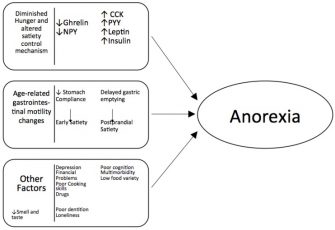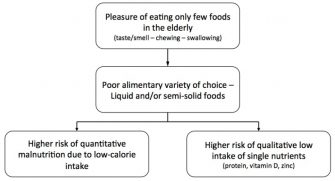Arm Yourself Against the Effects of Aging with Nutrition
 You are what you eat.
You are what you eat.
We’ve all heard it said, but do we really think about what that means? We typically think of nutrition as it relates to weight gain and loss, diabetes, or perhaps immunity or cholesterol numbers. However, proper nutrition is much more far reaching than a few isolated aspects of health.
The foods we eat not only fuel our body, but they BECOME our body. The various compounds and elements in our foods become the building blocks for new cells in the body; blood, muscle, bone, organ, every tissue in our body is made from the substances we consume. Thus, not only can chicken soup help you feel better when recovering from the flu, but consuming a variety of healthy foods can help you maintain your health as you age.
Improvement in sanitary, nutritional, and socioeconomic conditions is leading to longer life expectancies worldwide. In fact, according to the UN’s World Population Prospects 2022, the population of older persons (over 65) is growing at a faster rate than their younger counterparts. Those 65 or older made up 10% of the world’s population in 2022 and if current trends continue, that will rise to 16% in 2050.
Like it or not, as we age, changes in the body contribute to a functional. Often referred to as frailty, this decline leads to an increased risk of certain chronic conditions such as cardiovascular disease, diabetes, cancer, sarcopenia, and degenerative disorders.
Living longer allows genetics, environment, and health choices throughout life to compound or improve this process. This makes it even more important to make positive choices in the areas of life where we can promote good health.
One of the areas where we can make positive choices is our food selections. The research agrees. The scholarly journal “Nutrition” published a special issue, entitled “Nutrition and Healthy Aging” in 2022. The issue collected 14 research articles and 4 reviews and addressing themes such as dietary diversity, calorie restriction regimens, physical exercise, anti-aging agents, social issues, and strategies to promote healthy aging. The studies gathered data from China, Italy, Korea, Malaysia, Mexico, Saudi Arabia, Spain, and the United States of America.
Researchers who compiled the issue noted “The most marked message that emerges from this collection is the correlation between the frailty index and dietary diversity.” Due to the data being from so many countries with such different nutritional habits, they could not pinpoint any one specific diet to follow or avoid, but overall those with a “good diet variety score” had better frailty index scores. They summarized:
“adherence to Mediterranean diet for Europeans, the use of a balanced diet rich in vegetables in U.S., and the general balanced equilibrium of vegetables, oil, fish, and meat in the diet seems to have a major role in maintaining a lower frailty index and in the prevention of the non-communicable diseases.”
As people age, food consumption tends to decline at a greater rate than energy expenditure, leading to weight loss that seems to primarily affect skeletal muscle tissue. This “anorexia of aging” presents a significant obstacle to the health of older individuals.
CONTRIBUTING FACTORS
In a review published in 2016, researchers note the wide range of contributing factors to this paradigm.

Figure 1 Major mechanisms involved in the development of anorexia of aging.
The body regulates food intake through a complex process that serves to protect the feeding drive. However, in later years, these processes may begin to deteriorate. For instance, smell and taste play a large role in making eating enjoyable. Yet both of these senses tend to decrease with age. This leads many to consume less food overall. Since some taste buds decline faster than others (salty and sweet are among the first to go), people seek out what still tastes good. This can serve to both reduce variety and also may lead to consumption of foods that have less nutritional value, but still have flavor.
Hormones also play a significant role in hunger. Ghrelin, is known as the “hunger hormone” while Cholecystokinin (CCK) and peptide YY (PYY) are hormone that helps signal a person that they are full. Some studies have revealed an increase in CCK and/or PYY in older persons. This could make them feel fuller after a meal and lead to skipping the next meal.
Just as some motor skills slow with age, the function of internal organs can also slow. When the stomach is slower to empty, the body is continuing to get signals that it is full, making later meals feel unneeded.
Other factors, such as the reduced saliva secretions and tooth decay often experienced by many older adults can make it more difficult to eat. These further limits food options, making it even more difficult to consume the variety of nutrients that a person needs.
Additionally, there are several medical conditions such as gastrointestinal diseases, malabsorption syndromes, acute and chronic infections and depression, that may hinder a person’s ability and/or desire to eat. Some medications affect appetite and/or taste. Because many older adults are taking multiple medications, the interactions of those medications may increase these effects.

Figure 2 Anorexia of aging and risk of malnutrition.
Finally, socioeconomic factors also play a role in how much and how often people eat. Someone who lives alone may be less motivated to take time to cook a healthy meal for one person. Many older adults are on fixed incomes and the cost of food may play a significant role in their food choices, especially in times of economic inflation.
The good news is that many of these issues can be addressed!
PREVENTION
It is important to eat a wide variety of healthy foods early in life. This provides a healthy foundation for disease prevention. This also affords more options to continue to meet nutritional needs in spite of the various risk factors. If a certain food is no longer an option, then an alternative is already familiar. For instance, if an individual becomes unable to chew meat, they may have other favorites such as quinoa or beans that can be easily chewed as well as help fill that protein void.
Furthermore, it is important that individuals have a solid relationship with a health care provider such as a chiropractor, who can help watch for signs of anorexia and muscle loss, possibly before the individual notices themselves. Because anorexia of aging often affects musculoskeletal tissues first, chiropractors are in an excellent position to help monitor and advise patients as they age. They may also suggest exercises that can help strengthen muscle and combat the effects of anorexia and/or nutritional supplementation.
The Pan American Health Organization sums it up well.
Healthy aging is a continuous process of optimizing opportunities to maintain and improve physical and mental health, independence, and quality of life throughout the life course.
Many modern advances have already added years to our life. Now it’s time to add life to those years! Talk to your chiropractor at your next visit about your current nutritional and activity habits as they relate to your age. What can you do now, to help protect your quality of life as you get older? Sometimes simple changes can have profound effects on health.
Resources:
United Nations Dept of Economic and Social Affairs. “World Population Prospects 2022: Summary of Results July 2022 . https://www.un.org/development/desa/pd/ accessed 3/16/2023
Giacomello E, Toniolo L. Nutrition, Diet and Healthy Aging. Nutrients. 2021 Dec 31;14(1):190. doi: 10.3390/nu14010190. PMID: 35011068; PMCID: PMC8746852.
Arosio B, Cesari M. Nutrition and Muscle Health. Nutrients. 2021 Feb 28;13(3):797. doi: 10.3390/nu13030797. PMID: 33670994; PMCID: PMC7997193.
Landi F, Calvani R, Tosato M, Martone AM, Ortolani E, Savera G, Sisto A, Marzetti E. Anorexia of Aging: Risk Factors, Consequences, and Potential Treatments. Nutrients. 2016 Jan 27;8(2):69. doi: 10.3390/nu8020069. PMID: 26828516; PMCID: PMC4772033.
Pan American Health Organization. “Healthy Aging”. https://www.paho.org/en/healthy-aging accessed 3/16/2023